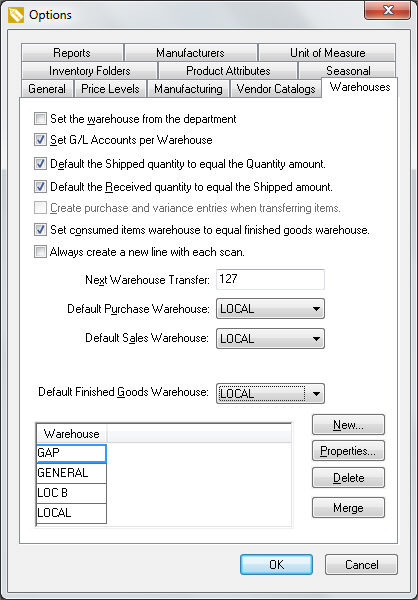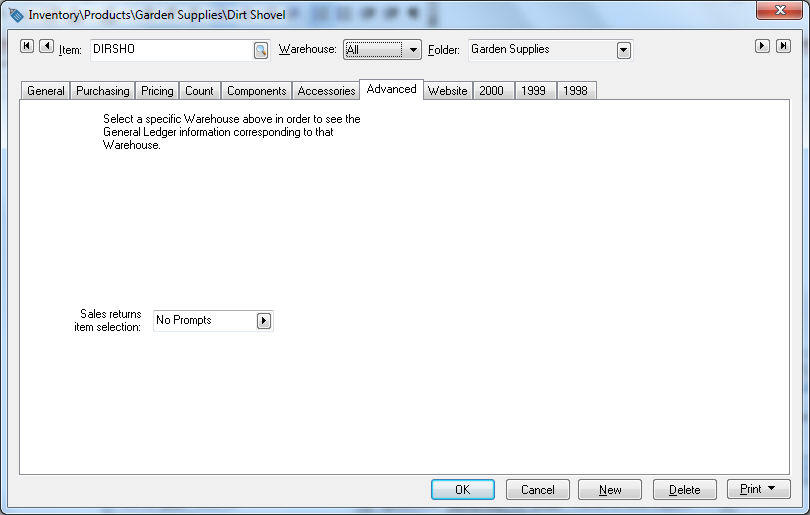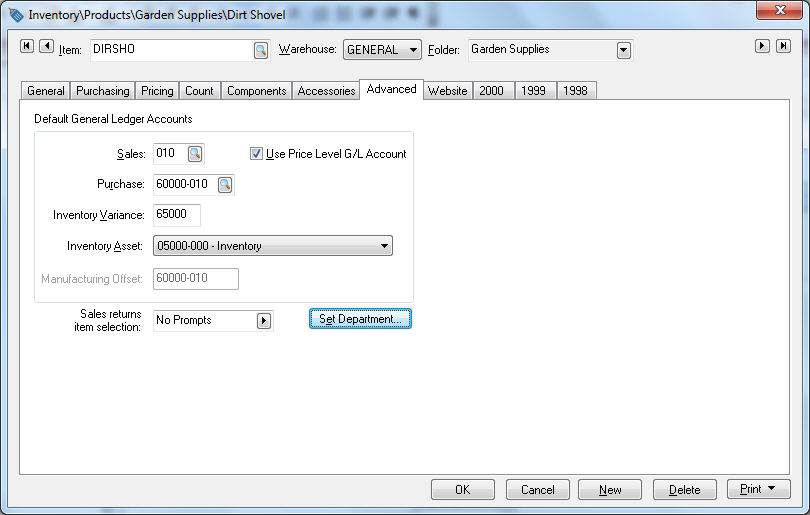- EBMS Knowledge Base
- Inventory
- Multiple Inventory Locations | Creating Locations
-
Client Resources
-
EBMS Main Documentation
- Introduction
- Getting Started
- Getting Started | Initial Installation
- Getting Started | Company Setup
- Quick User Guide | Financial Staff | Accountant
- Quick User Guide | Financial Staff | Accountant | Accountants Journal
- Quick User Guide | Sales Staff
- Quick User Guide | General Staff
- Features
- Reports
- Security
- Server Manager
- Technical
- Technical | Data Import and Export Utility
- Technical | SQL Mirror
- Automotive
- Automotive | Parts Catalog
- Automotive | Pricing
- Automotive | Point of Sale
- Automotive | Product Application
- Automotive | Keystone Interface
- Metal Supply
- Fuel Sales
- Horticulture
- Horticulture | Farm Setup
- Horticulture | Processing Payroll
- Horticulture | Managing the Farm
-
Sales
- Introduction
- Customers
- Customers | Miscellaneous Customers
- Proposals
- Proposals | Processing Proposals
- Proposals | Sets and Templates
- MyProposals
- MyOrders
- Sales Orders
- Invoices
- Materials Lists
- Sales and Use Tax
- Sales and Use Tax | TaxJar
- CRM
- CRM | Auto Send
- Recurring Billing
- Credits
- Customer Payments
- Payment Card Processing
- Payment Card Processing | Gift Cards
- Payment Card Processing | Loyalty Cards
- Payment Card Processing | Verifone Gateway
- Freight and Shipping Tools
- General Ledger Transactions
- Point of Sale
- Point of Sale | Point of Sale Hardware
- Point of Sale | Xpress POS System
- Point of Sale | Advanced Tools
- Signature Capture
- Salesperson Commissions
-
Inventory
- Product Catalog
- Product Catalog | Using Product Codes for No Count Items
- Product Pricing
- Product Pricing | Special Pricing
- Tracking Counts
- Unit of Measure
- Purchasing
- Special Orders and Drop Shipped Items
- Receiving Product
- Barcodes
- MyInventory and Scanner
- Components (BOM) and Accessories
- Components (BOM) and Accessories | Component Formula Tool
- Made-to-Order Kitting
- Configure-to-Order Kitting
- Multiple Inventory Locations
- Multiple Inventory Locations | Creating Locations
- Multiple Inventory Locations | Using Multiple Locations
- Multiple Inventory Locations | Product Catalog Sync
- Multi-Vendor Catalog
- Serialized Items
- Serialized Items | Purchasing or Manufacturing an Item
- Serialized Items | Selling and/or Associating an item with a customer
- Lots
- Product Attributes
- Product Attributes | Selling and Purchasing Items with Attributes
- Product Attributes | Custom Attributes
- Mobile Scanner (Legacy)
-
Labor
- Getting Started
- Workers
- Taxes and Deductions
- Work Codes
- Time and Attendance
- Time and Attendance | Time Track App
- Processing Payroll
- Closing the Payroll Year
- Processing Payroll - Advanced
- Salaried Pay
- Piecework Pay
- Direct Deposit
- 3rd Party Payroll Service
- Subcontract Workers
- Flag Pay
- Prevailing Wages
- MyDispatch
- MyTasks
- MyTime
- MyTime | Communications
- MyTime | Setup
- Tasks
- Tasks | Getting Started
- Tasks | Creating Tasks
- Tasks | Scheduling Tasks
- Tasks | Customizing Task Views
- Tasks | Managing Tasks
-
Financials
- Introduction
- Fiscal Year
- Chart of Accounts
- Budget
- Financial Reporting
- Transactions and Journals
- Transactions and Journals | Journals
- Account Reconciliation
- 1099
- Departments and Profit Centers
- Fund Accounts
- Bank Accounts
- Bank Feed
- Vendors
- Vendors | Miscellaneous Vendors
- Purchase Orders
- Expense Invoices
- Vendor Payments
- AP Transactions
- Landed Cost
- Fixed Assets and Depreciation
- Fixed Assets and Depreciation | Fixed Assets
- Fixed Assets and Depreciation | Fixed Assets | Adding Assets
- Fixed Assets and Depreciation | Processing Depreciation
- Fixed Assets and Depreciation | Disposing Assets
- MyJobs
-
E-commerce
-
Rental
-
Job Costing
-
Manufacturing
Associating Multiple Departments for each Inventory Item
This section describes the settings required to configure EBMS to allow many departments within a warehouse.
Go to Inventory > Options > Warehouses tab to open the following window:

The Set the warehouse from the department option must be disabled and the Set G/L Accounts per Warehouse must be enabled.
Enable the Default the Shipped quantity to equal the Quantity amount option unless the user enters the products in the inventory transfer list before the transfer step is processed. This option should be enabled in normal situations.
Enable the Default the Received quantity to equal the Shipped amount option if the product is received within the target warehouse at the same time it is shipped from the source warehouse. Review the Using Multiple Locations > Transferring Inventory between Warehouses section for more details.
Disable the Create purchase and variance entries when transferring items option in a normal process. Review the Generate Purchase and Variance Transactions for Warehouse Transfers Option section for more details.
The Set consumed items warehouse to equal finished goods warehouse option is used within the manufacturing window. Review the Manufacturing > Creating a Batch > Multiple Warehouses section within the manufacturing section for more details.
Disable the Always create a new line with each scan option to increment the quantity Shipped instead of creating a new line for each scan. This option only applies when using barcode scanners. Review [Sales] Point of Sale > barcodes > Scanning barcodes sfor more details on scanning barcodes.
The Next Warehouse Transfer number is a sequential number used in the Warehouse Transfer window. Review the Managing Inventory within a Warehouse and Transferring Inventory between Warehouses sections for details on the Warehouse Transfer window.
Click on the New button to add a new warehouse. Review the Create Warehouses section for detailed instructions on creating warehouses.
Enter the Default Purchase Warehouse. The expense invoice and Inventory > Warehouse Transfer windows will default to this setting.
Set the Default Sales Warehouse that will be used in the sales invoice. This setting is used on the main inventory lookup list. These defaults are user-defined so that each user may select their individual defaults.
Review the Manufacturing > Creating a Batch > Multiple Warehouses section within the for details on the Default Consumed Items Warehouse setting. Click OK to save option settings.
The general ledger accounts are associated with each warehouse within the inventory item. Open the Advanced tab of an inventory item as shown below:

The general ledger settings must be set for each warehouse. Change the Warehouse setting from the All option to a warehouse option. The general ledger codes can be set for the selected department as shown below:

Review the Product Catalog > Changing Inventory Defaults section or details regarding the advanced tab settings.
Use the Edit Defaults feature and filter down department values to globally change the department setting for each warehouse. Review [Main] Features > Change Defaults, Filtering Down Data and Globally Changing Data for details.
